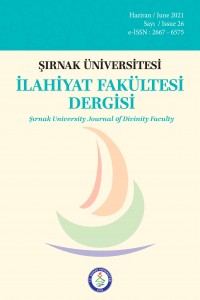Abstract
Keywords
Exegesis Contemporary Commentaries Archeology Qur'anic Interpretation The Parable of Noah Noah's Flood
References
- Ateş, Süleyman. Kur’ân-ı Kerim Tefsiri. 6 Cilt. İstanbul: Yeni Ufuklar Neşriyat, 1998.
- Ay, Eyüp. ''İlahî Mesaj'ın Kadim Medeniyetlerdeki İzdüşümleri: Kur'an'ın Arka planına Arkeolojik Bir Yaklaşım'', İslami Araştırmalar 9/ 1-2-3-4 (1996), 184-196.
- Aydın, Hayati. ''Şüphe Edilmez Bir Hakikat Olarak Hz. Nûh ve Tufan Olayı'', Bingöl Üniversitesi İlahiyat Fakültesi Dergisi 14 (2019), 39-50.
- Dartma, Bahattin. Kur'an ve Arkeoloji. İstanbul: Pınar Yayınları, 2005.
- Demirci, Muhsin. Tefsir Usulü. İstanbul: Marmara İlahiyat Vakfı Yayınları, 4. Basım, 2016.
- Eliaçık, İhsan. Yaşayan Kur'an. İstanbul: İnşa Yayınları, 2007.
- Elmalı'lı, M. Hamdi Yazır. Hak Dini Kur'an Dili. 10 Cilt. İstanbul: Eser Neşriyat, 1979
- Esed, Muhammed. Kur'an Mesajı. Ankara: İşaret Yayınları, 2002.
- Harputi, Abdullatif. Tenkihu'l-Kelam. İstanbul, 1912.
- Hatip, Muhammed Abdullatif. Evdahu't-tefasir. Mısır: Matbaatu Mısriyye, 1964.
- İbn Aşur, Muhammed Tahir. et-Tahrir ve't-tenvir. 30 Cilt. Tunus: Daru Tunusiyye, 1984.
- Karaman, Hayrettin ve Diğerleri. Kur'an Yolu. 5 Cilt. Ankara: Diyanet İşleri Başkanlığı Yayınları, 3. Basım, 2007.
- Kaya, Mesut. ''Çağdaş Tefsirlerde Hz. Nûh ve Cudi Dağı: Tefsiru'l –Menar ve Tefhîmu'l-Kur'an Örneği''. Uluslararası Hz. Nûh ve Cudi Dağı Sempozyumu. ed. Hamdi Gündoğar, Ömer Ali Yıldırım - Mehmet Ata Az. 327-341. Şırnak: Şırnak Üniversitesi Yayınları, 2013.
- Kaya, Mesut. ''Dönemsel İlmi Şartların Müfessirin Donanımı üzerindeki Belirleyeciliği –Klasik ve Modern Dönem Mukayesesi-''. Marife (Kış 2013), 10-31.
- Kırca, Celal. Kurân-ı Kerim ve Modern İlimler. İstanbul: Marifet yayınları,1981.
- Kitab-ı Mukaddes. İstanbul: Yeni Yaşam Yayınları, 2016. Yaratılış/Tekvin, Bab: 8.
- Merağî, Ahmed b. Mustafa. Tefsiru'l-merağî. Mısır: Mustafa el-Babi el-Halebi, 1946.
- Mevdûdî, Ebu'l Al'â. Tefhimu'l-Kuran. 7cilt. İstanbul: İnsan Yayınları, 2. Basım, 1996.
- Özdemir, Ahmet. ''Kur'an'ı Anlamada Yeni Bir Yöntem Önerisi Olarak Kur'an Arkeolojisi'', İslami Araştırmalar Dergisi 30/2 (2019), 278-297.
- Özdoğan, Mehmet. 50 Soruda Arkeoloji. İstanbul: Bilim ve Gelecek Kitaplığı, 2011.
- Paçacı, Mehmet. ''Çağdaş Dönemde Kur'an'a ve Tefsir'e Ne Oldu?'', İslamiyat. 4/4 (2003), 85-104.
- Rıza, M. Reşit. Tefsiru'l – menar. 12 cilt. Kahire: Hey'etü'l- Mısrıyye, 1990.
- Sarıkçıoğlu, Ekrem. ''Kur'an ve Arkeoloji Işığında Hz. Nûh ve Tufan Olayına Yeni Bir Yaklaşım'', İslami Araştırmalar. 9/1.2.3.4 (1996), 197-203.
- Sarıkçıoğlu, Ekrem. ''Kur'an ve Arkeoloji Işığında Nûh Tufanı'', Uluslararası Şırnak ve Çevresi Sempozyumu. ed. M. Nesim Doru. 26-33. Ankara: Şırnak Üniversitesi Yayınları, 2010.
- Şimşek, M. Said. Günümüz Tefsir Problemleri. Konya: Kitap dünyası yayınları, 2004.
- Tantavi, Cevheri. el-Cevâhir fî tefsiri'l-Kur'âni'l-Kerim. 26 Cilt. Mısır: Mustafa el-Babi el-Halebi, 1940.
- Zuhayli, Vehbi Mustafa. Tefsiru'l-munir. 30 Cilt. Şam: Daru'l –fikr, 1997.
Abstract
References
- Ateş, Süleyman. Kur’ân-ı Kerim Tefsiri. 6 Cilt. İstanbul: Yeni Ufuklar Neşriyat, 1998.
- Ay, Eyüp. ''İlahî Mesaj'ın Kadim Medeniyetlerdeki İzdüşümleri: Kur'an'ın Arka planına Arkeolojik Bir Yaklaşım'', İslami Araştırmalar 9/ 1-2-3-4 (1996), 184-196.
- Aydın, Hayati. ''Şüphe Edilmez Bir Hakikat Olarak Hz. Nûh ve Tufan Olayı'', Bingöl Üniversitesi İlahiyat Fakültesi Dergisi 14 (2019), 39-50.
- Dartma, Bahattin. Kur'an ve Arkeoloji. İstanbul: Pınar Yayınları, 2005.
- Demirci, Muhsin. Tefsir Usulü. İstanbul: Marmara İlahiyat Vakfı Yayınları, 4. Basım, 2016.
- Eliaçık, İhsan. Yaşayan Kur'an. İstanbul: İnşa Yayınları, 2007.
- Elmalı'lı, M. Hamdi Yazır. Hak Dini Kur'an Dili. 10 Cilt. İstanbul: Eser Neşriyat, 1979
- Esed, Muhammed. Kur'an Mesajı. Ankara: İşaret Yayınları, 2002.
- Harputi, Abdullatif. Tenkihu'l-Kelam. İstanbul, 1912.
- Hatip, Muhammed Abdullatif. Evdahu't-tefasir. Mısır: Matbaatu Mısriyye, 1964.
- İbn Aşur, Muhammed Tahir. et-Tahrir ve't-tenvir. 30 Cilt. Tunus: Daru Tunusiyye, 1984.
- Karaman, Hayrettin ve Diğerleri. Kur'an Yolu. 5 Cilt. Ankara: Diyanet İşleri Başkanlığı Yayınları, 3. Basım, 2007.
- Kaya, Mesut. ''Çağdaş Tefsirlerde Hz. Nûh ve Cudi Dağı: Tefsiru'l –Menar ve Tefhîmu'l-Kur'an Örneği''. Uluslararası Hz. Nûh ve Cudi Dağı Sempozyumu. ed. Hamdi Gündoğar, Ömer Ali Yıldırım - Mehmet Ata Az. 327-341. Şırnak: Şırnak Üniversitesi Yayınları, 2013.
- Kaya, Mesut. ''Dönemsel İlmi Şartların Müfessirin Donanımı üzerindeki Belirleyeciliği –Klasik ve Modern Dönem Mukayesesi-''. Marife (Kış 2013), 10-31.
- Kırca, Celal. Kurân-ı Kerim ve Modern İlimler. İstanbul: Marifet yayınları,1981.
- Kitab-ı Mukaddes. İstanbul: Yeni Yaşam Yayınları, 2016. Yaratılış/Tekvin, Bab: 8.
- Merağî, Ahmed b. Mustafa. Tefsiru'l-merağî. Mısır: Mustafa el-Babi el-Halebi, 1946.
- Mevdûdî, Ebu'l Al'â. Tefhimu'l-Kuran. 7cilt. İstanbul: İnsan Yayınları, 2. Basım, 1996.
- Özdemir, Ahmet. ''Kur'an'ı Anlamada Yeni Bir Yöntem Önerisi Olarak Kur'an Arkeolojisi'', İslami Araştırmalar Dergisi 30/2 (2019), 278-297.
- Özdoğan, Mehmet. 50 Soruda Arkeoloji. İstanbul: Bilim ve Gelecek Kitaplığı, 2011.
- Paçacı, Mehmet. ''Çağdaş Dönemde Kur'an'a ve Tefsir'e Ne Oldu?'', İslamiyat. 4/4 (2003), 85-104.
- Rıza, M. Reşit. Tefsiru'l – menar. 12 cilt. Kahire: Hey'etü'l- Mısrıyye, 1990.
- Sarıkçıoğlu, Ekrem. ''Kur'an ve Arkeoloji Işığında Hz. Nûh ve Tufan Olayına Yeni Bir Yaklaşım'', İslami Araştırmalar. 9/1.2.3.4 (1996), 197-203.
- Sarıkçıoğlu, Ekrem. ''Kur'an ve Arkeoloji Işığında Nûh Tufanı'', Uluslararası Şırnak ve Çevresi Sempozyumu. ed. M. Nesim Doru. 26-33. Ankara: Şırnak Üniversitesi Yayınları, 2010.
- Şimşek, M. Said. Günümüz Tefsir Problemleri. Konya: Kitap dünyası yayınları, 2004.
- Tantavi, Cevheri. el-Cevâhir fî tefsiri'l-Kur'âni'l-Kerim. 26 Cilt. Mısır: Mustafa el-Babi el-Halebi, 1940.
- Zuhayli, Vehbi Mustafa. Tefsiru'l-munir. 30 Cilt. Şam: Daru'l –fikr, 1997.
Details
| Primary Language | Turkish |
|---|---|
| Subjects | Religious Studies |
| Journal Section | RESEARCH ARTICLES |
| Authors | |
| Publication Date | June 15, 2021 |
| Submission Date | March 8, 2021 |
| Acceptance Date | March 30, 2021 |
| Published in Issue | Year 2021 Issue: 26 |
Cited By
Yaklaşan Son Sâat’in Ön Göstergeleri
Amasya İlahiyat Dergisi
https://doi.org/10.18498/amailad.1355798
Şırnak University Journal of Divinity Faculty is licensed under a Creative Commons Attribution-NonCommercial 4.0 International License (CC BY NC).


